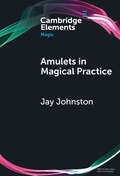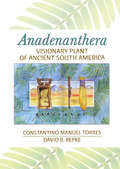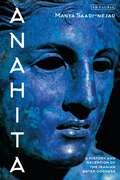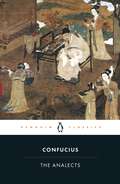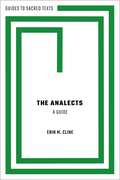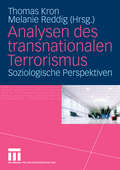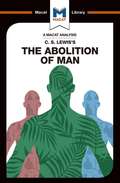- Table View
- List View
Amos and the Cosmic Imagination
by James R. LinvilleSaid to contain the words of the earliest of the biblical prophets (8th century BCE), the book of Amos is reinterpreted by the author in light of new and sometimes controversial historical approaches to the Bible. Amos is read as the literary product of the Persian-era community in Judah. Its representations of divine-human communication are investigated in the context of the ancient writers' own role as transmitters and shapers of religious traditions. Amos's extraordinary poetry expresses mythical conceptions of divine manifestation and a process of destruction and recreation of the cosmos which reveals that behind the appearances of the natural world is a heavenly, cosmic temple.
Amos and the Cosmic Imagination
by James R. LinvilleSaid to contain the words of the earliest of the biblical prophets (8th century BCE), the book of Amos is reinterpreted by the author in light of new and sometimes controversial historical approaches to the Bible. Amos is read as the literary product of the Persian-era community in Judah. Its representations of divine-human communication are investigated in the context of the ancient writers' own role as transmitters and shapers of religious traditions. Amos's extraordinary poetry expresses mythical conceptions of divine manifestation and a process of destruction and recreation of the cosmos which reveals that behind the appearances of the natural world is a heavenly, cosmic temple.
Amos in Song and Book Culture (The Library of Hebrew Bible/Old Testament Studies)
by Joyce Rilett WoodThis study argues that the gist and movement of the prophecy in the book of Amos can be attributed to Amos himself, who composed a coherent cycle of poetry. His dire predictions came after the Fall of Samaria but before the Fall of Jerusalem. Writing a century later, the author of the book preserved but updated Amos' text by fitting it into a developing literary, historical and prophetic tradition. Amos is used as a test case to show that prophecy originated in the performing arts but was later transformed into history and biography. The original prophecy is a song Amos recited at symposia or festivals. The book's interest focusses on the performer and his times.
Amplifying Islam in the European Soundscape: Religious Pluralism and Secularism in the Netherlands (Islam of the Global West)
by Pooyan Tamimi ArabPublic manifestations of Islam remain fiercely contested across the Global West. Studies to date have focused on the visual presence of Islam – the construction of mosques or the veiling of Muslim women. Amplifying Islam in the European Soundscape is the first book to add a sonic dimension to analyses of the politics of Islamic aesthetics in Europe. Sound does not respect public/private boundaries, and people experience sound viscerally. As such, the public amplification of the azan, the call to prayer, offers a unique opportunity to understand what is at stake in debates over religious toleration and secularism. The Netherlands were among the first European countries to allow the amplification of the azan in the 1980s, and Pooyan Tamimi Arab explores this as a case study embedded in a broader history of Dutch religious pluralism. The book offers a pointed critique of social theories that regard secularism as all-encompassing. While cultural forms of secularism exclude Muslim rights to public worship, Amplifying Islam in the European Soundscape argues that political and constitutional secularism also enables Muslim demands for amplifying calls to prayer. It traces how these exclusions and inclusions are effected through proposals for mosques, media debates, law and policy, but also in negotiations on the ground between residents, municipalities and mosques.This book is open access and available on www.bloomsburycollections.com. It is funded by the Religious Matters in an Entangled World program, Utrecht University.
Amsterdam's Sephardic Merchants and the Atlantic Sugar Trade in the Seventeenth Century
by Yda SchreuderThis book surveys the role of Amsterdam’s Sephardic merchants in the westward expansion of sugar production and trade in the seventeenth-century Atlantic. It offers an historical-geographic perspective, linking Amsterdam as an emerging staple market to a network of merchants of the “Portuguese Nation,” conducting trade from the Iberian Peninsula and Brazil. Examining the “Myth of the Dutch,” the “Sephardic Moment,” and the impact of the British Navigation Acts, Yda Schreuder focuses attention on Barbados and Jamaica and demonstrates how Amsterdam remained Europe’s primary sugar refining center through most of the seventeenth century and how Sephardic merchants played a significant role in sustaining the sugar trade.
Amulets in Magical Practice (Elements in Magic)
by null Jay JohnstonThis Element takes as its remit the production and use of amulets. The focus will be on amulets with no, or minimal, textual content like those comprising found stone, semi-precious gem and/or animal body parts. That is a material form that is unaccompanied by directive textual inscription. The analysis considers this materiality to understand its context of use including ritual and metaphysical operations. Through discussion of selected case studies from British, Celtic, and Scandinavian cultures, it demonstrates the associative range of meaning that enabled the attribution of power/agency to the amuletic object Uniquely, it will consider this material culture from an interdisciplinary perspective, drawing together insights from the disciplines of cultural studies, religious studies, 'folk' studies, archaeology and Scandinavian studies. It develops the concept of 'trans-aniconism' to encapsulates an amulet's temporal relations and develops the proposition of 'landscape amulets.'
The Anabaptist Story: An Introduction To Sixteenth-century Anabaptism
by William R. EstepFour hundred seventy years ago the Anabaptist movement was launched with the inauguration of believer’s baptism and the formation of the first congregation of the Swiss Brethren in Zurich, Switzerland. This standard introduction to the history of Anabaptism by noted church historian William R. Estep offers a vivid chronicle of the rise and spread of teachings and heritage of this important stream in Christianity. This third edition of The Anabaptist Story has been substantially revised and enlarged to take into account the numerous Anabaptist sources that have come to light in the last half-century as well as the significant number of monographs and other scholarly works on Anabaptist themes that have recently appeared. Estep challenges a number of assumptions held by contemporary historians and offers fresh insights into the Anabaptist movement.
Anadenanthera: Visionary Plant of Ancient South America
by Constantino M Torres David B RepkeA multidisciplinary study of pre-Columbian South America-centering on the psychoactive plant genus AnadenantheraAs cultures formed and evolved in pre-Columbian South America, Anadenanthera became one of the most widely used shamanic inebriants. Anadenanthera: Visionary Plant of Ancient South America is more than a comprehensive reference on shamanic visionary substances; it is a useful tool for archeologists and pre-Columbian art historians. This thorough book examines the ritual and cultural use of Anadenanthera from prehistory to the present, along with its botany, chemistry, pharmacology, anthropology, and archeology.The earliest evidence for the use of psychoactive plants in South America is provided by remains of seeds and pods recovered from archeological sites four millennia old. Various preparations were derived from it with the intent of being a shamanic inebriant. Inhaled through the nose, smoked in pipes or as cigars, and prepared in fermented drinks, Anadenanthera served a central role in the cultural development of indigenous societies in South America. Anadenanthera: Visionary Plant of Ancient South America explores the full spectrum of information gleaned from research, covering numerous archeological sites in the Andean region, as well as discussing Amazonian shamanic rituals and lore. Analyses of the artistic expressions within the decorations of associated ceremonial paraphernalia such as ritual snuffing tubes and snuff trays are included. The text is richly illustrated with photographs and images of decorated ritual implements, and provides a comprehensive bibliography.Anadenanthera: Visionary Plant of Ancient South America explores: botanical aspects, taxonomy, and geographical distribution of Anadenanthera ethnographical, historical, and traditional aspects of Anadenanthera use chemical and pharmacological investigations of the genus and the various visionary preparations derived from it-with emphasis on the biologically active constituents theories of the mechanisms of action of the active tryptamines and carboline alkaloids comparisons of wood anatomy, morphology, and percentage of alkaloid content evaluation of stylistic and iconographic traitsAnadenanthera: Visionary Plant of Ancient South America is a thorough, useful resource for archeologists, anthropologists, chemists, researchers, pre-Columbian art historians, and any layperson interested in pre-Columbian art, archeology, or visionary plants.
Anadenanthera: Visionary Plant of Ancient South America
by Constantino M Torres David B RepkeA multidisciplinary study of pre-Columbian South America-centering on the psychoactive plant genus AnadenantheraAs cultures formed and evolved in pre-Columbian South America, Anadenanthera became one of the most widely used shamanic inebriants. Anadenanthera: Visionary Plant of Ancient South America is more than a comprehensive reference on shamanic visionary substances; it is a useful tool for archeologists and pre-Columbian art historians. This thorough book examines the ritual and cultural use of Anadenanthera from prehistory to the present, along with its botany, chemistry, pharmacology, anthropology, and archeology.The earliest evidence for the use of psychoactive plants in South America is provided by remains of seeds and pods recovered from archeological sites four millennia old. Various preparations were derived from it with the intent of being a shamanic inebriant. Inhaled through the nose, smoked in pipes or as cigars, and prepared in fermented drinks, Anadenanthera served a central role in the cultural development of indigenous societies in South America. Anadenanthera: Visionary Plant of Ancient South America explores the full spectrum of information gleaned from research, covering numerous archeological sites in the Andean region, as well as discussing Amazonian shamanic rituals and lore. Analyses of the artistic expressions within the decorations of associated ceremonial paraphernalia such as ritual snuffing tubes and snuff trays are included. The text is richly illustrated with photographs and images of decorated ritual implements, and provides a comprehensive bibliography.Anadenanthera: Visionary Plant of Ancient South America explores: botanical aspects, taxonomy, and geographical distribution of Anadenanthera ethnographical, historical, and traditional aspects of Anadenanthera use chemical and pharmacological investigations of the genus and the various visionary preparations derived from it-with emphasis on the biologically active constituents theories of the mechanisms of action of the active tryptamines and carboline alkaloids comparisons of wood anatomy, morphology, and percentage of alkaloid content evaluation of stylistic and iconographic traitsAnadenanthera: Visionary Plant of Ancient South America is a thorough, useful resource for archeologists, anthropologists, chemists, researchers, pre-Columbian art historians, and any layperson interested in pre-Columbian art, archeology, or visionary plants.
Anahita: A History and Reception of the Iranian Water Goddess
by Manya Saadi-nejadAnahita was the most important goddess of pre-Islamic Iran. From her roots as an ancient Indo-European water deity her status was unrivalled by any other Iranian goddess throughout the course of three successive Iranian empires over a period of a thousand years.The first scholarly book on Anahita, this study reconstructs the Indo-European water goddess through a comparison of Celtic, Slavic, Armenian and Indo-Iranian myths and rituals. Anahita's constantly-evolving description and functions are then traced through the written and iconographic records of Iranian societies from the Achaemenid period onwards, including but not limited to the Zoroastrian texts and the inscriptions and artistic representations of the great pre-Islamic Iranian empires. The study concludes by tracing survival of the goddess in Islamic Iran, as seen in new Persian literature and popular rituals. Manya Saadi-nejad demonstrates the close relationship between Iranian mythology and that of other Indo-European peoples, and the significant cultural continuities from Iran's pre-Islamic period into the Islamic present.
Anahita: A History and Reception of the Iranian Water Goddess
by Manya Saadi-nejadAnahita was the most important goddess of pre-Islamic Iran. From her roots as an ancient Indo-European water deity her status was unrivalled by any other Iranian goddess throughout the course of three successive Iranian empires over a period of a thousand years.The first scholarly book on Anahita, this study reconstructs the Indo-European water goddess through a comparison of Celtic, Slavic, Armenian and Indo-Iranian myths and rituals. Anahita's constantly-evolving description and functions are then traced through the written and iconographic records of Iranian societies from the Achaemenid period onwards, including but not limited to the Zoroastrian texts and the inscriptions and artistic representations of the great pre-Islamic Iranian empires. The study concludes by tracing survival of the goddess in Islamic Iran, as seen in new Persian literature and popular rituals. Manya Saadi-nejad demonstrates the close relationship between Iranian mythology and that of other Indo-European peoples, and the significant cultural continuities from Iran's pre-Islamic period into the Islamic present.
The Analects: Or The Conversations Of Confucius With His Disciples And Certain Others, (Ideas For Life Ser.)
by Confucius D. C. LauThe Analects express a philosophy, or a moral code, by which Confucius, one of the most humane thinkers of all time, believed everyone should live. Upholding the ideals of wisdom, self-knowledge, courage and love of one's fellow man, he argued that the pursuit of virtue should be every individual's supreme goal. And, while following the Way, or the truth, might not result in immediate or material gain, Confucius showed that it could nevertheless bring its own powerful and lasting spiritual rewards.
The Analects: A Guide (Guides to Sacred Texts)
by Erin M. ClineThe Analects (Lunyu) is the earliest and most influential record of the teachings of Kongzi (551-479 B.C.E.), known to most Westerners as "Confucius." If we measure influence according to the number of people who have lived their lives according to the teachings of a particular text, there is a good argument to be made that the Analects has been the most influential text in the world. This book argues that we have good reasons to study the Analects as a sacred text, and that doing so sheds light not only on the text and the Confucian tradition, but on what the sacred is, more broadly. It begins by examining what it means for a text to be regarded as sacred in relation to the unique history of this remarkably influential book, and goes on to offer a close study of the Analects, including its structure, its composition and compilation, and the purpose it has served in the Confucian tradition as the earliest and most authoritative record of Kongzi's teachings and conduct. The book further considers the history of the Analects as the most authoritative collection of Confucian teachings which virtually all major Confucians--as well as Chinese thinkers throughout history from the Mohist, Daoist, and Buddhist traditions--responded. This book explores the text, situating its teachings in relation to the religious practices of its time (including Zhou rituals and customs known as li and the veneration of ancestor and nature spirits), and discusses the Analects use and reception both in the periods following its composition and compilation and throughout China's imperial history up through the modern era, including the recent revival of activity in Confucian temples.
The Analects: A Guide (Guides to Sacred Texts)
by Erin M. ClineThe Analects (Lunyu) is the earliest and most influential record of the teachings of Kongzi (551-479 B.C.E.), known to most Westerners as "Confucius." If we measure influence according to the number of people who have lived their lives according to the teachings of a particular text, there is a good argument to be made that the Analects has been the most influential text in the world. This book argues that we have good reasons to study the Analects as a sacred text, and that doing so sheds light not only on the text and the Confucian tradition, but on what the sacred is, more broadly. It begins by examining what it means for a text to be regarded as sacred in relation to the unique history of this remarkably influential book, and goes on to offer a close study of the Analects, including its structure, its composition and compilation, and the purpose it has served in the Confucian tradition as the earliest and most authoritative record of Kongzi's teachings and conduct. The book further considers the history of the Analects as the most authoritative collection of Confucian teachings which virtually all major Confucians--as well as Chinese thinkers throughout history from the Mohist, Daoist, and Buddhist traditions--responded. This book explores the text, situating its teachings in relation to the religious practices of its time (including Zhou rituals and customs known as li and the veneration of ancestor and nature spirits), and discusses the Analects use and reception both in the periods following its composition and compilation and throughout China's imperial history up through the modern era, including the recent revival of activity in Confucian temples.
The Analects of Dasan, Volume I: A Korean Syncretic Reading
by Hongkyung KimWith extensive research and creative interpretations, Dasan's Noneo gogeum ju (Old and New Commentaries of the Analects) has been evaluated in the academia of Korean Studies as a crystallization of his studies on the Confucian classics. Dasan (Jeong Yak-yong: 1762-1836) attempted through this book to synthesize and overcome the lengthy scholarly tradition of the classical studies of the Analects, leading it not only to represent one of the greatest achievements of Korean Confucianism but also demonstrate an innovative prospect for the progress of Confucian philosophy, positioning it as one of the ground-breaking works in all Confucian legacies in East Asia. Originally consisting of forty volumes in traditional book binding, his Noneo gogeum ju contains one hundred and seventy-five new interpretations on the Analects, hundreds of "arguments" about the neo-Confucian commentaries, hundreds of references to the scholarly works of the Analects, thousands of supportive quotations from various East Asian classics for the author's arguments, and hundreds of philological discussions. This book is an English translation of Noneo gogeum ju with the translator's comments on the innovative ideas and interpretations of Dasan on the Analects.
The Analects of Dasan, Volume I: A Korean Syncretic Reading
by Hongkyung KimWith extensive research and creative interpretations, Dasan's Noneo gogeum ju (Old and New Commentaries of the Analects) has been evaluated in the academia of Korean Studies as a crystallization of his studies on the Confucian classics. Dasan (Jeong Yak-yong: 1762-1836) attempted through this book to synthesize and overcome the lengthy scholarly tradition of the classical studies of the Analects, leading it not only to represent one of the greatest achievements of Korean Confucianism but also demonstrate an innovative prospect for the progress of Confucian philosophy, positioning it as one of the ground-breaking works in all Confucian legacies in East Asia. Originally consisting of forty volumes in traditional book binding, his Noneo gogeum ju contains one hundred and seventy-five new interpretations on the Analects, hundreds of "arguments" about the neo-Confucian commentaries, hundreds of references to the scholarly works of the Analects, thousands of supportive quotations from various East Asian classics for the author's arguments, and hundreds of philological discussions. This book is an English translation of Noneo gogeum ju with the translator's comments on the innovative ideas and interpretations of Dasan on the Analects.
The Analects of Dasan, Volume III: A Korean Syncretic Reading
by Hongkyung KimWith extensive research and creative interpretations, Dasan's Noneo gogeum ju (Old and New Commentaries of the Analects) has been evaluated in Korean Studies as a crystallization of his studies on the Confucian classics. Dasan (Jeong Yak-yong: 1762-1836) attempted to synthesize and overcome the lengthy scholarly tradition of the classical studies of the Analects, leading it not only to become one of the greatest achievements of Korean Confucianism but also to demonstrate an innovative prospect for the progress of Confucian philosophy. Through this, he has positioned it as one of the ground-breaking works in all Confucian legacies in East Asia. Originally consisting of forty volumes in traditional bookbinding, his Noneo gogeum ju contains one hundred and seventy-five new interpretations on the Analects, hundreds of arguments about the neo-Confucian commentaries of the Analects commentaries, hundreds of references to the scholarly works of the Analects, thousands of supportive quotations from various East Asian classics for the author's arguments, and hundreds of philological discussions. This book is the third volume of an English translation of Noneo gogeum ju with the translator's comments on the innovative ideas and interpretations of Dasan on the Analects.
The Analects of Dasan, Volume III: A Korean Syncretic Reading
by Hongkyung KimWith extensive research and creative interpretations, Dasan's Noneo gogeum ju (Old and New Commentaries of the Analects) has been evaluated in Korean Studies as a crystallization of his studies on the Confucian classics. Dasan (Jeong Yak-yong: 1762-1836) attempted to synthesize and overcome the lengthy scholarly tradition of the classical studies of the Analects, leading it not only to become one of the greatest achievements of Korean Confucianism but also to demonstrate an innovative prospect for the progress of Confucian philosophy. Through this, he has positioned it as one of the ground-breaking works in all Confucian legacies in East Asia. Originally consisting of forty volumes in traditional bookbinding, his Noneo gogeum ju contains one hundred and seventy-five new interpretations on the Analects, hundreds of arguments about the neo-Confucian commentaries of the Analects commentaries, hundreds of references to the scholarly works of the Analects, thousands of supportive quotations from various East Asian classics for the author's arguments, and hundreds of philological discussions. This book is the third volume of an English translation of Noneo gogeum ju with the translator's comments on the innovative ideas and interpretations of Dasan on the Analects.
The Analects of Dasan, Volume IV: A Korean Syncretic Reading
by Hongkyung KimFor its extensive research and novel interpretations, Dasan's Noneo gogeum ju (Old and New Commentaries of the Analects) is considered in Korean Studies a crystallization of Dasan's study of the Confucian classics. Dasan (Jeong Yak-yong: 1762-1836) attempted to synthesize and supersede the lengthy scholarly tradition of the classical studies of the Analects, leading to work that not only proved to be one of the greatest achievements of Korean Confucianism but also definitively demonstrated innovative prospects for the study of Confucian philosophy. It is one of the most groundbreaking works among all Confucian legacies in East Asia. Originally consisting of forty volumes in traditional bookbinding, Noneo gogeum ju contains one hundred and seventy-five new interpretations on the Analects, hundreds of arguments about the neo-Confucian commentaries on the Analects, hundreds of references to scholarly works on the Analects, thousands of supporting quotations from various East Asian classics for the author's arguments, and hundreds of philological discussions. This book is the fourth volume of an English translation of Noneo gogeum ju and includes the translator's comments on the innovative ideas and interpretations of Dasan's commentaries.
The Analects of Dasan, Volume IV: A Korean Syncretic Reading
by Hongkyung KimFor its extensive research and novel interpretations, Dasan's Noneo gogeum ju (Old and New Commentaries of the Analects) is considered in Korean Studies a crystallization of Dasan's study of the Confucian classics. Dasan (Jeong Yak-yong: 1762-1836) attempted to synthesize and supersede the lengthy scholarly tradition of the classical studies of the Analects, leading to work that not only proved to be one of the greatest achievements of Korean Confucianism but also definitively demonstrated innovative prospects for the study of Confucian philosophy. It is one of the most groundbreaking works among all Confucian legacies in East Asia. Originally consisting of forty volumes in traditional bookbinding, Noneo gogeum ju contains one hundred and seventy-five new interpretations on the Analects, hundreds of arguments about the neo-Confucian commentaries on the Analects, hundreds of references to scholarly works on the Analects, thousands of supporting quotations from various East Asian classics for the author's arguments, and hundreds of philological discussions. This book is the fourth volume of an English translation of Noneo gogeum ju and includes the translator's comments on the innovative ideas and interpretations of Dasan's commentaries.
The Analects of Dasan, Volume V: A Korean Syncretic Reading
by Hongkyung KimFor its extensive research and novel interpretations, Dasan's Noneo gogeum ju (Old and New Commentaries of the Analects) is considered in Korean Studies a crystallization of Dasan's study of the Confucian classics. Dasan (Jeong Yak-yong: 1762-1836) attempted to synthesize and supersede the lengthy scholarly tradition of the classical studies of the Analects, leading to work that not only proved to be one of the greatest achievements of Korean Confucianism but also definitively demonstrated innovative prospects for the study of Confucian philosophy. It is one of the most groundbreaking works among all Confucian legacies in East Asia. Originally consisting of forty volumes in traditional bookbinding, Noneo gogeum ju contains one hundred and seventy-five new interpretations on the Analects, hundreds of arguments about the neo-Confucian commentaries on the Analects, hundreds of references to scholarly works on the Analects, thousands of supporting quotations from various East Asian classics for the author's arguments, and hundreds of philological discussions. This book is the fifth volume of an English translation of Noneo gogeum ju and includes the translator's comments on the innovative ideas and interpretations of Dasan's commentaries.
The Analects of Dasan, Volume V: A Korean Syncretic Reading
by Hongkyung KimFor its extensive research and novel interpretations, Dasan's Noneo gogeum ju (Old and New Commentaries of the Analects) is considered in Korean Studies a crystallization of Dasan's study of the Confucian classics. Dasan (Jeong Yak-yong: 1762-1836) attempted to synthesize and supersede the lengthy scholarly tradition of the classical studies of the Analects, leading to work that not only proved to be one of the greatest achievements of Korean Confucianism but also definitively demonstrated innovative prospects for the study of Confucian philosophy. It is one of the most groundbreaking works among all Confucian legacies in East Asia. Originally consisting of forty volumes in traditional bookbinding, Noneo gogeum ju contains one hundred and seventy-five new interpretations on the Analects, hundreds of arguments about the neo-Confucian commentaries on the Analects, hundreds of references to scholarly works on the Analects, thousands of supporting quotations from various East Asian classics for the author's arguments, and hundreds of philological discussions. This book is the fifth volume of an English translation of Noneo gogeum ju and includes the translator's comments on the innovative ideas and interpretations of Dasan's commentaries.
Analysen des transnationalen Terrorismus: Soziologische Perspektiven
by Thomas Kron Melanie ReddigWie ist Terrorismus soziologisch zu erklären? Der Band liefert erste Antworten auf diese Frage aus unterschiedlichen Theorie- und Analyseperspektiven.
An Analysis of C.S. Lewis's The Abolition of Man (The Macat Library)
by Ruth Jackson Brittany Pheiffer NobleC.S. Lewis’s 1943 The Abolition of Man is a set of three essays that encapsulate some of the most important elements of good critical thinking. Lewis considers a weighty topic, moral philosophy – and more precisely how we teach it, and where morality comes from. As critics and enthusiasts for Lewis’s work alike have noted, though, he was not a philosopher as such, but a professor of literature. And rather than presenting novel or original ideas, the essays’ true qualities lie in the ways in which they evaluate and judge the arguments of prior philosophers, and how they construct a coherent, highly persuasive argument for Lewis’s own point of view. Lewis takes issue with textbooks and philosophies that argue for (or imply) that all morals and moral judgments are relative. He deploys evaluative skills to point out the weaknesses in such arguments and then sets out for his readers the kind of moral future such relativism could lead to. This hard-hitting evaluation, in turn, provides a solid base upon which to construct a well-argued counter-proposal, that moral laws can be absolute, and stem from objective, universal values. Persuasive and enthralling, The Abolition of Man showcases reasoning at its best.
An Analysis of C.S. Lewis's The Abolition of Man (The Macat Library)
by Ruth Jackson Brittany Pheiffer NobleC.S. Lewis’s 1943 The Abolition of Man is a set of three essays that encapsulate some of the most important elements of good critical thinking. Lewis considers a weighty topic, moral philosophy – and more precisely how we teach it, and where morality comes from. As critics and enthusiasts for Lewis’s work alike have noted, though, he was not a philosopher as such, but a professor of literature. And rather than presenting novel or original ideas, the essays’ true qualities lie in the ways in which they evaluate and judge the arguments of prior philosophers, and how they construct a coherent, highly persuasive argument for Lewis’s own point of view. Lewis takes issue with textbooks and philosophies that argue for (or imply) that all morals and moral judgments are relative. He deploys evaluative skills to point out the weaknesses in such arguments and then sets out for his readers the kind of moral future such relativism could lead to. This hard-hitting evaluation, in turn, provides a solid base upon which to construct a well-argued counter-proposal, that moral laws can be absolute, and stem from objective, universal values. Persuasive and enthralling, The Abolition of Man showcases reasoning at its best.




